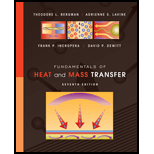
Concept explainers
A process fluid having a specific heat of
Want to see the full answer?
Check out a sample textbook solution
Chapter 11 Solutions
Fundamentals of Heat and Mass Transfer
Additional Engineering Textbook Solutions
Heating Ventilating and Air Conditioning: Analysis and Design
Statics and Mechanics of Materials (5th Edition)
Applied Statics and Strength of Materials (6th Edition)
Vector Mechanics for Engineers: Statics and Dynamics
Manufacturing Engineering & Technology
Statics and Mechanics of Materials
- Water flowing in a long, aluminum lube is to be heated by air flowing perpendicular to the exterior of the tube. The ID of the tube is 1.85 cm, and its OD is 2.3 cm. The mass flow rate of the water through the tube is 0.65kg/s, and the temperature of the water in the lube averages 30C. The free-stream velocity and ambient temperature of the air are 10m/sand120C, respectively. Estimate the overall heat transfer coefficient for the heat exchanger using appropriate correlations from previous chapters. State all your assumptions.arrow_forward10.1 In a heat exchanger, as shown in the accompanying figure, air flows over brass tubes of 1.8-cm 1D and 2.1-cm OD containing steam. The convection heat transfer coefficients on the air and steam sides of the tubes are , respectively. Calculate the overall heal transfer coefficient for the heal exchanger (a) based on the inner tube area and (b) based on the outer tube area.arrow_forwardGlycerin (cp = 2400 J/kg·K) at 20°C and 0.5 kg/s is to be heated by ethylene glycol (cp = 2500 J/kg·K) at 60°C in a thin-walled double-pipe parallel-flow heat exchanger. The temperature difference between the two fluids is 15°C at the outlet of the heat exchanger. If the overall heat transfer coefficient is 240 W/m2·K and the heat transfer surface area is 3.2 m2, determine (a) the rate of heat transfer, (b) the outlet temperature of the glycerin, and (c) the mass flow rate of the ethylene glycol.arrow_forward
- In a textile manufacturing plant, the waste dyeing water (cp = 4295 J/kg·K) at 75°C is to be used to preheat fresh water (cp = 4180 J/kg·K) at 15°C at the same flow rate in a double-pipe counter-flow heat exchanger. The heat transfer surface area of the heat exchanger is 1.65 m2 and the overall heat transfer coefficient is 625 W/m2·K. If the rate of heat transfer in the heat exchanger is 35 kW, determine the outlet temperature and the mass flow rate of each fluid stream.arrow_forwardIn a double-pipe, counter-flow heat exchanger, water entering at 1.5 kg/s is heated from 25°C to 70°C as it flows thru the inner pipe. Hot oil enters the heat exchanger at 2.5 kg/s and 115°C. The convection heat transfer coefficients in the cold- and hot-sides are 100 and 50 kW/m2∙°C, respectively. Calculate the required heat transfer area in m2. Take cp = 4.18 kJ/kg∙°C for water and cp = 1.67 kJ/kg∙°C for oil.arrow_forwardA double-pipe parallel-flow heat exchanger is used to heat water (cp = 4180 J/kg·K) from 25°C to 60°C at a rate of 0.2 kg/s. The heating is accomplished by geothermal water (cp = 4310 J/kg·K) available at 134°C at a mass flow rate of 0.3 kg/s. The inner tube is thin-walled and has a diameter of 0.8 cm. If the overall heat transfer coefficient of the heat exchanger is 550 W/m2·K, determine the length of the tube required to achieve the desired heating. (Round the answer to a single decimal place.) The length of the tube required to achieve the desired heating is ________ m.arrow_forward
- Why does a “mixed” or “unmixed” fluid arrangement influence heat-exchanger performance?arrow_forwardA cross-flow heat exchanger with both fluids unmixed has an overall heat transfer coefficient of 200 W/m2·K, and a heat transfer surface area of 400 m2. The hot fluid has a heat capacity of 40,000 W/K, while the cold fluid has a heat capacity of 80,000 W/K. If the inlet temperatures of both hot and cold fluids are 80°C and 20°C, respectively, determine (a) the exit temperature of the hot fluid and (b) the rate of heat transfer in the heat exchanger.arrow_forwardWater (cp = 4180 J/kg·K) is to be heated by solarheated hot air (cp = 1010 J/kg·K) in a double-pipe counter- flow heat exchanger. Air enters the heat exchanger at 90°C at a rate of 0.3 kg/s, while water enters at 22°C at a rate of 0.1 kg/s. The overall heat transfer coefficient based on the inner side of the tube is given to be 80 W/m2·K. The length of the tube is 12 m and the internal diameter of the tube is 1.2 cm. Determine the outlet temperatures of the water and the air.arrow_forward
- Oil in an engine is being cooled by air in a crossflow heat exchanger, where both fluids are unmixed. Oil (cph = 2047 J/kg·K) flowing with a flow rate of 0.026 kg/s enters the tube side at 75°C, while air (cpc = 1007 J/kg·K) enters the shell side at 30°C with a flow rate of 0.21 kg/s. The overall heat transfer coefficient of the heat exchanger is 53 W/m2·K and the total surface area is 1 m2. If the correction factor is F = 0.96, determine the outlet temperatures of the oil and air.arrow_forwardUnder what conditions can a counter-flow heat exchanger have an effectiveness of one? What would your answer be for a parallel-flow heat exchanger?arrow_forwardHot water at 60℃ is cooled to 36℃ through the tube side of a 1–shell pass and 2-tube passesheat exchanger. The coolant is also a water stream, for which the inlet and outlet temperaturesare 7℃ and 31℃, respectively. The overall heat transfer coefficient and the heat transfer areaare 950 W/m2 K and 15 m2 , respectively. Calculate the mass flow rates of hot and cold waterstreams in steady operation. (Answers: 3.63 kg/s for both stream)arrow_forward
 Principles of Heat Transfer (Activate Learning wi...Mechanical EngineeringISBN:9781305387102Author:Kreith, Frank; Manglik, Raj M.Publisher:Cengage Learning
Principles of Heat Transfer (Activate Learning wi...Mechanical EngineeringISBN:9781305387102Author:Kreith, Frank; Manglik, Raj M.Publisher:Cengage Learning
